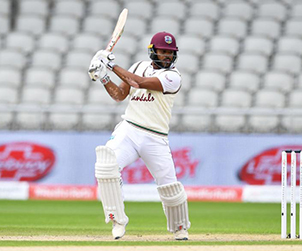In a Test that has lost 43 overs to rain, and is expected to lose even more, West Indies’ bowling discipline, exemplified by their captain Jason Holder, could prove the difference between losing and drawing.
For the 336th time in the series, Jason Holder ran up to the bowling crease. The 335 previous times, he had powered through the crease with hope and expectation, followed through, and gone back to the top of his run-up, or to the umpire to retrieve his floppy hat, a wicketless bowler.
In the overs preceding this one, he had come closer than ever. Three times he had appealed loudly, perhaps even confidently, after striking Ajinkya Rahane’s front pad. All three times, Aleem Dar had shaken his head. And, on closer examination, he seemed to have made the right decision each time.
Apart from the incoming deliveries, Holder had also bowled a few that had gone the other way. Twice in one over, he had nipped the ball past Rahane’s outside edge.
All these close shaves had occurred in the space of eight straight overs Holder had delivered from the Michael Holding End, named after a man who took a wicket every 50.9 balls he bowled in Test cricket. At that rate, Holding would have taken 6.58 wickets in 335 balls.
Whether the 0.58 was no wicket or an extra wicket might have depended on the umpire at his end.
Holder’s 336th ball of the series, in the ninth over of his Monday-morning spell from the Michael Holding End, came back in off the pitch, and kept a shade low. Wriddhiman Saha, going back and across to defend, couldn’t bring his bat down quickly enough, or along the right line, to keep the ball from hitting his back pad.
Holder appealed. Aleem Dar raised his finger. Replays, with the benefit of imaginary lines drawn along the length of the pitch, suggested only a fraction of the ball had struck the pad in front of off stump. Umpire’s call, and it was out according to this umpire. Bowling from Dar’s end, Holding might have had seven wickets rather than six in 335 balls.
Nonetheless, the wicket was fair reward for an unflagging spell of probing seam bowling. It was reward for Holder’s persistence right through India’s innings. On Sunday morning, he had bowled a relentless fifth-stump line to KL Rahul and Cheteshwar Pujara, and had earned their respect – Pujara, who made 46, only scored one run off the 38 balls he faced from Holder – but not their wickets.
By the time India declared, Holder’s figures reflected the respect all of India’s batsmen had shown him: 34.2-12-72-1, and an economy rate of 2.09. He had played a large part in India scoring at less than three an over through their innings, and as a consequence needing to spend more time at the crease than they may have desired in order to build the lead they wanted.
In a Test match that has lost 43 overs to rain, and is expected to lose even more time on the fourth and fifth days, West Indies’ bowling discipline, exemplified by Holder, their captain, could prove the difference between losing and drawing, or at least between losing and having a fighting chance of drawing.
Before the start of the series, Holder had defined himself – and Carlos Brathwaite – as a workhorse. Here he had played the role as well as he could have.
But he had taken only one wicket, and his economy rate was down in large part to a pitch that continued to offer bounce and seam movement even halfway into day three. His bowling at Sabina Park had showcased both his strengths and his limitations.
In the first Test in Antigua, on a pitch that offered the fast bowlers bounce but little else, he had looked a lot less impressive. Bowling with control but little incision, he had ended the first day with figures of 0 for 41 in 17 overs. At the start of day two, against two set batsmen in Virat Kohli and R Ashwin, even his good-length balls went for boundaries in a four-over spell that cost him 30 runs.
Right from the start of his career, Holder has looked like an international cricketer, whether he’s running up to bowl or driving down the ground with that combination of orthodox technique and extreme reach. But he has always looked like a fourth seamer, a batsman with the potential to bat at No. 6, and perhaps someone who could captain the side after gaining a little more experience. Instead, he has usually been West Indies’ third seamer, or sometimes even a new-ball bowler, batted at No. 8, and captained them.
England have done something similar with Moeen Ali, and attempted to convert a middle-order batsman who bowls handy offspin into a frontline spinner who bats at No. 8. It has not always worked, but England play most of their Test cricket on pitches where their spinner does not need to bowl long spells. Their attack also contains four Test-class fast bowlers, one of whom also bats in the top six.
West Indies are not blessed with those resources. Holder – and Brathwaite, when he plays – does not have that sort of cushion around him. By squeezing him into this uneasy situation, West Indies have simply reduced the impact one of their more talented players could be making. Holder has worked hard to be everything he is asked to be, but he, and his team, will probably be better off if he’s just allowed to be himself.






















